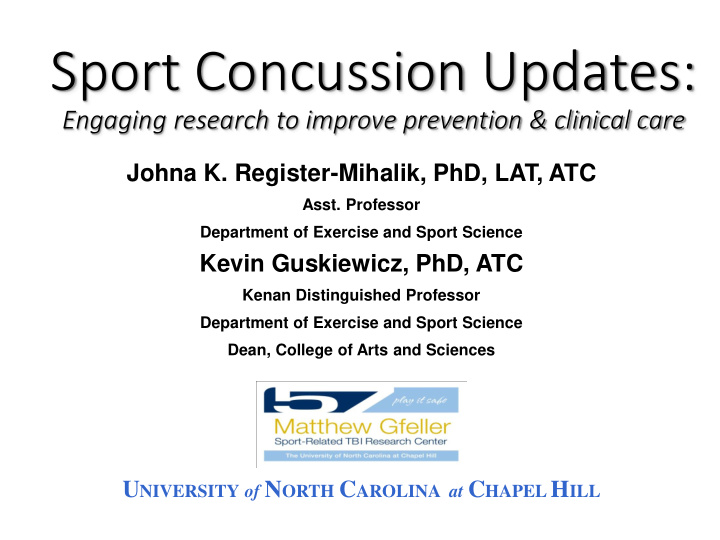



Sport Concussion Updates: Engaging research to improve prevention & clinical care Johna K. Register-Mihalik, PhD, LAT, ATC Asst. Professor Department of Exercise and Sport Science Kevin Guskiewicz, PhD, ATC Kenan Distinguished Professor Department of Exercise and Sport Science Dean, College of Arts and Sciences U NIVERSITY of N ORTH C AROLINA at C HAPEL H ILL
Injury Definition: Sports Concussion • “ Concussion is a traumatic brain injury induced by biomechanical forces. Several common features that may be utilized in defining the nature of a concussive head injury include… ”
Definition 1. Concussion may be caused either by a direct blow to the head, face, neck or elsewhere on the body with an ‘‘ impulsive ’’ force transmitted to the head. 2. Concussion typically results in the rapid onset of short- lived impairment of neurologic function that resolves spontaneously. However in some cases symptoms and signs may evolve over a number of minutes to hours. 3. Concussion may result in neuropathological changes but the acute clinical signs and symptoms largely reflect a functional disturbance rather than a structural injury and as such, no abnormality is seen on standard structural neuroimaging studies. 4. Concussion results in range of clinical signs and symptoms that may or may not involve loss of consciousness. Resolution of the clinical and cognitive symptoms typically follows a sequential course. However it is important to note that in some cases, may be prolonged The clinical signs and symptoms cannot be explained by drug, alcohol or medication use, other injuries (such as cervical injuries, peripheral vestibular dysfunction, etc) or other comorbidities (eg psychological factors or coexisting medical conditions)
“Energy Crisis”!
Concussion: A Multifaceted Condition Postural Symptoms Control Physical Cognition Exam Mechanism Visual/Vesti of Injury bular Concussion Psychological history Knowledge, Cognition Concussion Attitudes, Behaviors
Potential Issues with Mismanagement Worsening of Prolonged Long Term Short Term post-concussive concussion signs and symptoms (daily Issues Issues symptoms basis) Repeat Depression, concussion with cognitive post concussion impairment, syndrome dementia Long-term School-related academic issues issues in student in student athletes athletes Second Impact Syndrome Decreased (younger Quality of Life athletes)
Multimodal Assessment Paradigm (Broglio, 2008; Register-Mihalik 2011 & 2012) History Observation Symptoms Predispositions Palpation ROM & Strength of Neck Functional Stress Tests Testing • Cognition Postural • Coordination Control/Balance • Cranial Nerves • Visual/Vestibular Slide courtesy of Dr. Scott Bruce
Return to Sport Progression Symptom Limited Activity Light Aerobic Activity Sport Specific Exercise Non-Contact Training Full Contact Training Return to Sport / Full Contact Return to Play
Then vs. Now… When comparing data in 2014 to data collected between 1999-2004 (Pfaller, 2016) • >99% of athletes managed with a symptom free waiting period prior to return to sport (vs 60%). • Symptom free waiting period now longer (6 vs. 3 days) • Time from injury to return to sport is longer (12 vs. 7 days) • Important : Suggests most athletes not being returned inside the window of cerebral vulnerability.
Average Recovery Times In a recent study of 143 High School & College Athletes (Pfaller, 2016): • 72% have symptom recovery in 7 days • 93.7% in 2 weeks • 99% in 1-month
What We Think We Know: We have good tools for assessing concussion. Athletes are safer when taught the proper techniques and fundamentals of their respective sports at the appropriate age. When coaches, parents and youth athletes are taught effective concussion recognition and response, athletes are safer.
What We Think We Know ( con’t ): Rule enforcement of unsafe player behavior that puts the head at risk for injury must be put into action. There is no consensus by medical experts for a specific age at which kids are safer to begin playing contact sports. Active management is better than strict rest after concussion. There are fewer athletes with repeat concussions and fewer with same day return to play.
What We Don’t Know: Concussion thresholds and why they vary from person to person. If playing contact sports for any number of years makes someone more susceptible to CTE. Best interventions for treating concussion.
Where Do We Go From Here?: Increased research emphasis on: Education and training; teaching the fundamentals the right way Improving concussion recognition and response (parents, coaches, players) Reducing contact, but not eliminating it when it’s part of the game. Understanding long-term effects.
Where Do We Go From Here? ( con’t ): Utilize instructional tools such as USA Football’s Heads Up Tackling. Identify predispositions to concussion. - Track head impacts to identify high risk behaviors, enforce rules, and modify behavior to protect the head. Follow the science so that recommendations can be evidence-based.
Where Do We Go From Here? ( con’t ): Healthcare professionals / medical providers should have unchallengeable authority in medical/health decision-making.
Thank You & Questions Johna K. Register-Mihalik, PhD, LAT, ATC johnamihalik johnakay@email.unc.edu |
Recommend
More recommend